About 4 years ago I found an unusual Sega Mega Drive/Sega Genesis clone. It all started when I bought at an online auction in Brazil what was described as a “Japanese Sega Mega Drive 2”. This is the best looking Sega Mega Drive/Genesis model IMHO, and the idea was to use the case for a Raspberry Pi project. When it arrived, it looked like this:
Sadly, it was dead on arrival. But since it was cheap and I wanted just the case, I didn’t care. The motherboard was tossed on the parts bin and I went on.
Fast forward some two and a half years. I was looking for a weekend project to let off some steam after a rough week and found the board. A quick inspection revealed the defect: a bad solder joint on one of the voltage regulators. After applying some fresh solder to the joint, the board started working again.
But I soon found out that it was not “Japanese”: a JP Bare Knuckle 2 cartridge was rejected with a TMSS warning screen. “Weird, a Japanese console should not reject a Japanese cart”. Red Flag One. “Let’s take a closer look, and see if I can do a region switch”, I thought.
The motherboard is a really good-looking one. Good quality solder joints, clean layout, discrete components for the M68K/Z80 and RAM from reputable brands (Motorola, Hitachi, Sony and NEC), a Sony CXA video encoder, an expansion connector, etc. Odd thing was: no SEGA copyrights anywhere, nor any indication of the revision/model (VA0, VA1, etc…). Red Flag Two.
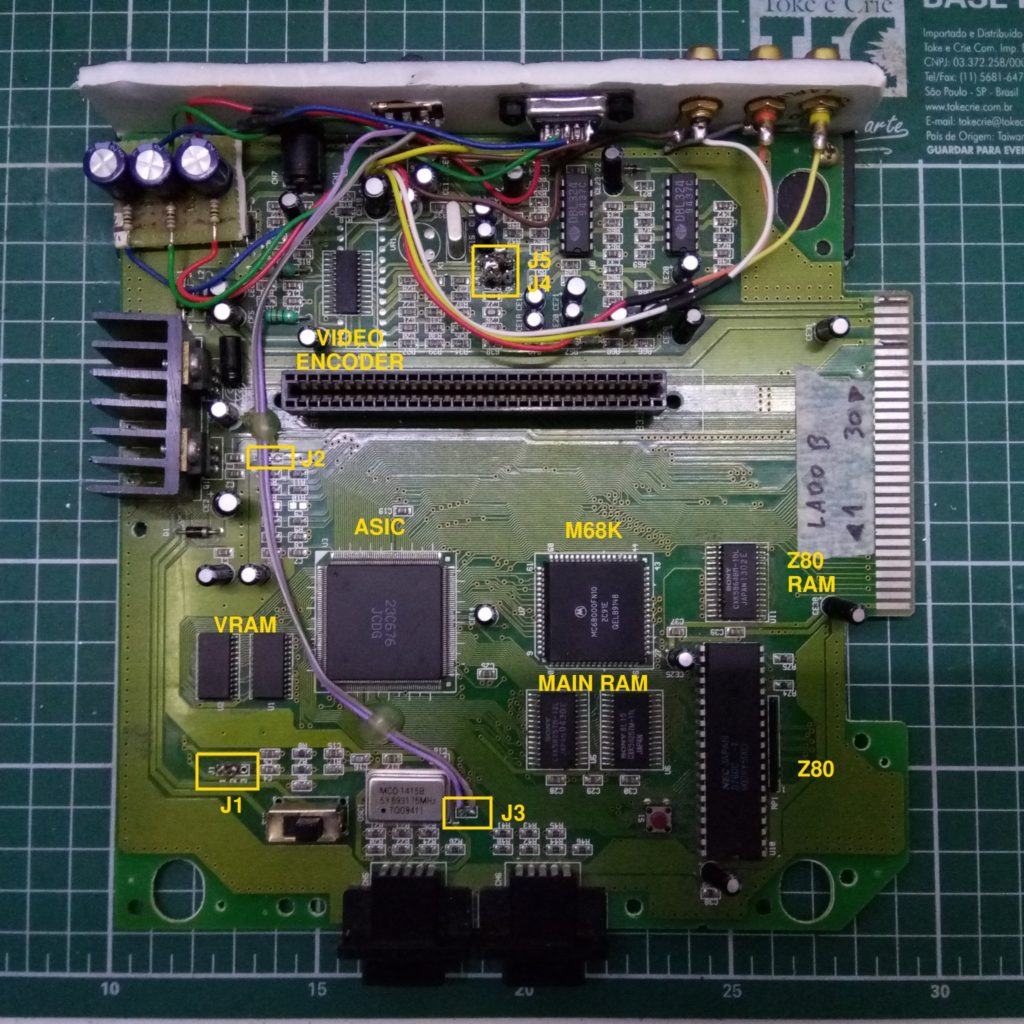
Overview of the board. Ignore the colored wires, back panel and big caps on the upper left side, there are mods I made.
OK, let’s check the PCB Revisions page on Sega Retro… and nothing matches. Then, something caught my eye: the ASIC with the VDP and audio processors was marked as
23C676 – JCDG. Definitely not a SEGA part, as those start with the 315- prefix and have the SEGA name on them. Red Flag Three! Ladies and Gentleman… we have a clone!
There is a sticker dating the board to June 26, 1995, and next to it K-1117 is inscribed on the ground plane. The question is: who would spend the energy and money to create such a high-quality clone, so late on the system’s life? Clones are usually “barely functional” and made in the cheapest way possible to maximize profits. None of that is true here.
Without a box or more info, we may never know the answer. But at least we can try to document what we know, so others with this board can follow our lead. All this information was gathered by the observation of two boards, one owned by me and the other by my friend Carlos Rodrigo. Huge thanks to Carlos for some of the pictures and the jumper mappings.
Hardware description
This is a two-layer, fiberglass board. Clean layout, with good quality solder joints, very different from cheap NES clones. Many components are discrete:
- CPU: Motorola MC68000FN10, PLCC68, can run at 10 MHz.
- Z80: NEC D780C-1, DIP40
- Z80/Sound RAM: Sony CXK5864BM-10L
- Main RAM: Sony CXK58257M-12L x2
- VRAM: NEC uPD42264LA-10 x2
- RGB Encoder: Sony CXA1145M
- ASIC: 23C676 JCDG or JDDD
Also dual ST Micro L7805CV voltage regulators, Dual Daewoo DBL324 quad op-amps, MCO 1415B oscillator rated at 53.693175 MHz, assorted discrete components. All electrolytic caps are from Wendell, a Taiwanese company. They are listed as “Bad Caps”, but none of them show signs of leakage.
23C676 Specifics
The 23C676 ASIC seems to be a clone of one of the “315-” ASICS by SEGA, which one is not clear. Since the Z80 is discrete, it could be the 315-5847, 315-5660, 315-5700 or 315-5708. Under the “model name” the code JCDG (on my board) or JDDD (on Carlos’s one) can be seen, maybe a mask revision? Carlos was kind enough to dessolder the chip from his board, and under it he found the code 4A091-A056.
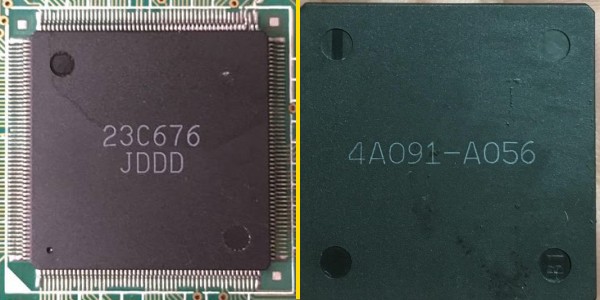
Besides JDDD, the chip was also found with the code JCDG. Maybe a mask revision? Photo by Carlos Rodrigo.
Jumper Settings
There are a number of jumpers on the board. Carlos mapped the effects of each one as follows:
Compatibility tests
Carlos reports that the board if fully compatible with the Power Base converter, Sega CD, Virtua Racing and the SEGA 32X. It also worked fine with Everdrive cartridges. For all purposes, this is a fully featured Sega Mega Drive. Nothing seems to be missing.
I removed the Model 2 A/V Out port on mine, and replaced it with a set of more standard connectors: a DE-15 for RGB (connected to a GBS-8200 modded with the GBS-Control firmware) and RCA connectors for composite video and stereo audio.
I had issues with RGB video on a “stock” GBS-8200: the board was not able to correctly position the image on the screen (requiring a manual adjustment) and the last 64 or so lines of the image wobbled constantly. With GBS-Control the positioning issues are gone and the image is rock solid. I do not know if this is the result of the original firmware not liking the Mega Drive output, or if the signal is slightly “off-spec” and the new firmware can better deal with it.
Do you have more info?
If you have any more information about this Sega Mega Drive / Genesis clone, please leave it on the comments below. I am specially interested in box/manual scans that could help us determine where it came from.

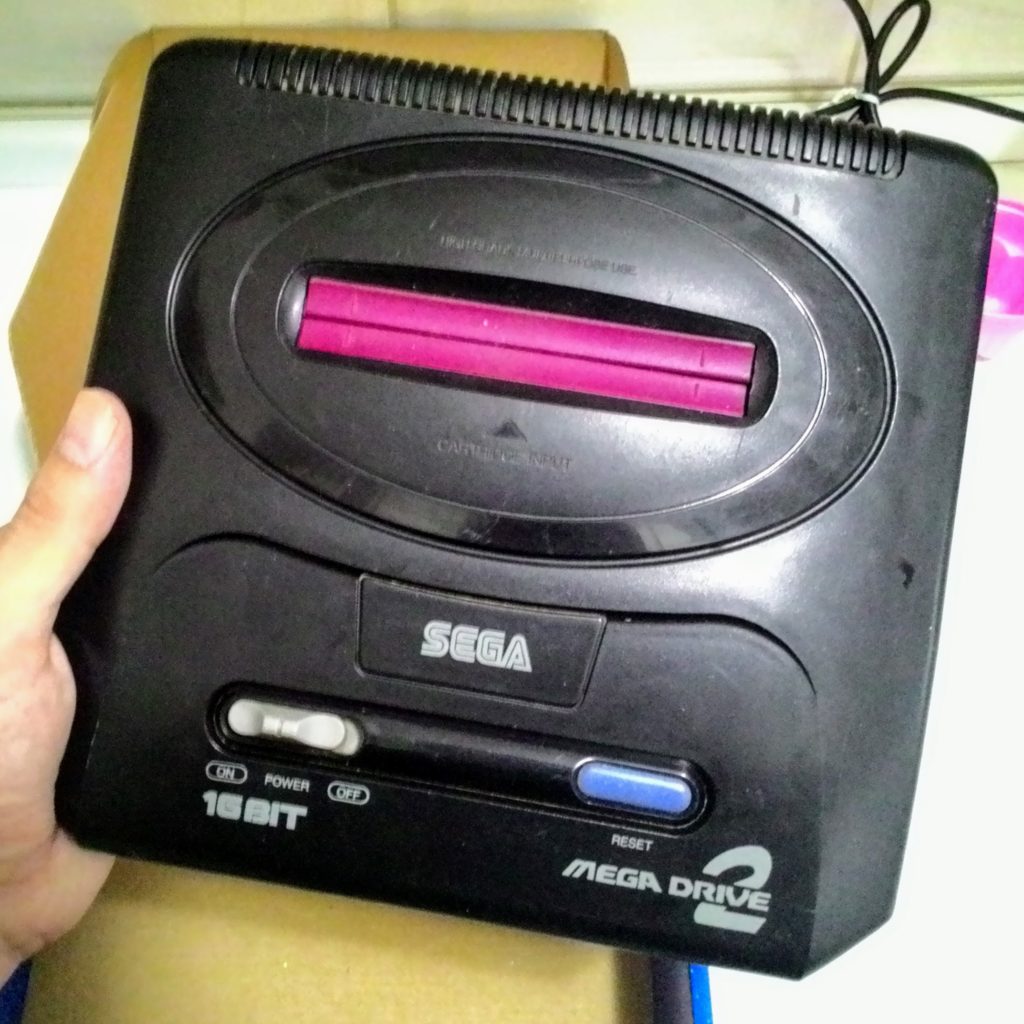
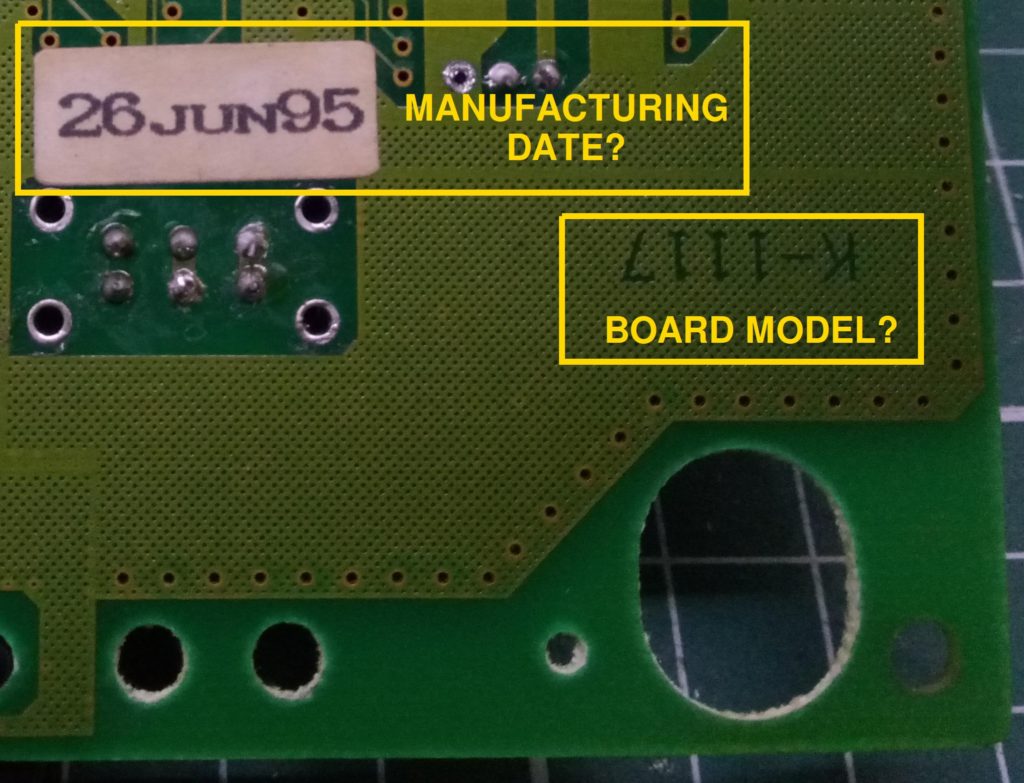
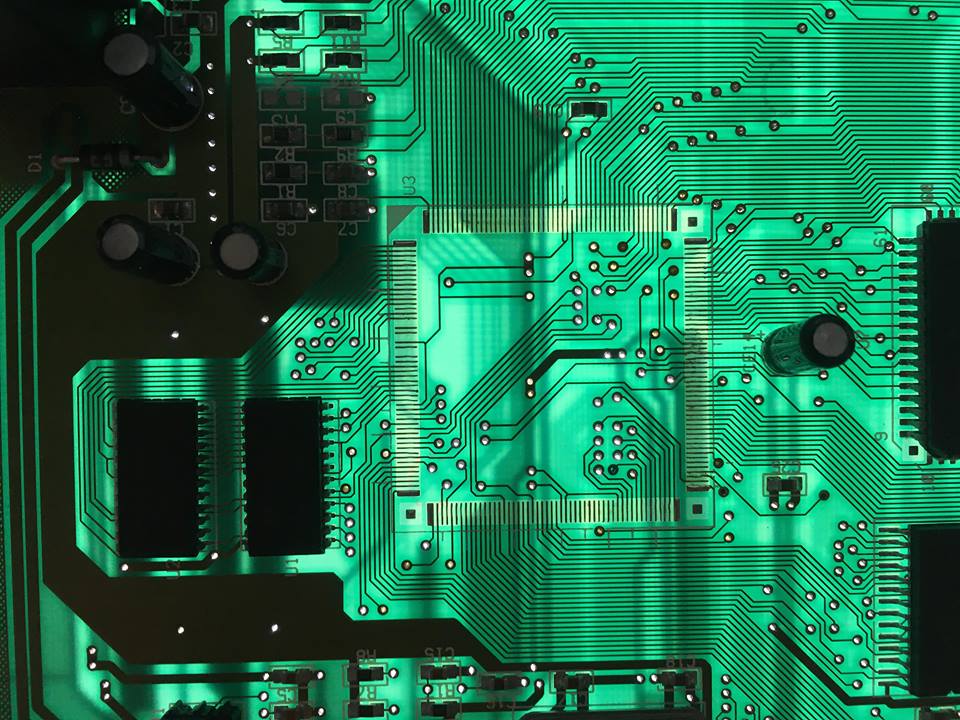
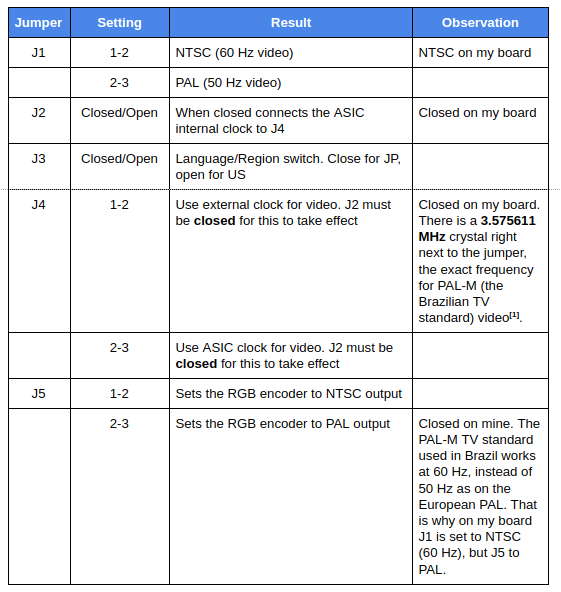
Hi. Rafael. if you are interested, I found a similar sega in Russia at a flea market, I can send photos for the article (only photos, because someone else bought it), the model is somehow rare. You can email me and I’ll send you a photo.
Hi Pavel. I recently bought another one here in Brazil, at the same website where I found the first one. The motherboard is almost the same, but the code printed on it is slightly different (K-1115 instead of K-1117). My guess is that those clones were fairly popular around here, and that a good number of the “Japanese” MD2 units in Brazil may be in fact clones!
Hey i also have some kind of mega drive 2 japanese clone that looks similar and it also doesn’t work I checked every compacitor and voltage regulator and I even tried reflowing but nothing worked maybe you some suggestions on how can i fix my clone ?
Oi Rafael.
Tempos atrás comprei um Mega Drive no Mercado Livre exatamente como esse seu. Também comprei ele achando se tratar de um modelo japonês mas logo descobri que era um clone, e pesquisando sobre ele acabei achando essa sua página.
Como ele veio sem fonte eu fui direto ligá-lo com uma fonte de Genesis 2/Mega Drive III que tenho aqui que uso tanto no 32X quanto em um Mega Drive III antigo que eu tenho, só que a fonte simplesmente não encaixa nesse clone.
Vi que a fonte do Mega Drive 1 japonês, que é o meu MD principal, encaixava e resolvi testar. O clone funcionou, mas após uns 20 segundos a imagem começou a ficar muito avermelhada e achei melhor desligá-lo pois a fonte do MD1 tem uma voltagem maior que a do MD2 e fiquei preocupado de queimar o console.
Você saberia qual é a fonte recomendada para se usar com ele? Me parece que as especificações na parte de baixo do console (as mesmas de um MD2 japonês), não batem com a realidade, principalmente por causa do tipo de plugue que não encaixa nele.
Oi Thiago. A fonte é a mesma do Mega Drive original, 9V com centro negativo. 1 Ampére deve ser o suficiente só para o console, usaria 1,5 Ampére se tiver expansões (Mega CD, 32X) conectadas.
Oi Rafael, voce teria fotos do adaptador AC desse cara? gostaria de saber a voltagem e polaridade pois perdi o meu, tentei usar uma fonte com as especificações do Mega 2 mas sem sucesso.
Oi Jj, ele não veio com o adaptador AC. A fonte é 9v, centro negativo, com plugue “P4”. É a mesma dos Mega Drive 1. 1 Ampére deve ser o suficiente.
hi
here it is mine clone SMD-2 board from turkey
https://images2.imgbox.com/32/42/EeUWL7Jc_o.jpeg
on the picture, the chip over the cartridge input is Sony branded
Below the cartridge, these 2 vertical and parallel chips have logo like mitsubishi?!
like these ones, at the right of the AMD
Next two close to the controllers are something like NES? NEC? SNEC?
me, again.
forgot the drop the link of mitsubishi like chip that i mentioned in the second paragraph above
http://nemesis.hacking-cult.org/MegaDrive/TeraDrive/Pictures/IMG_0844.JPG
Esse post foi util não achei em nenhum lugar referências a está placa, obrigado mas é um clone de qualidade
Pingback: Sega Genesis Clone: The 16 BIT Mega Drive 2 - PCBurn
Olá Rafael, muito bom esse artigo. Ontem consegui um Mega 2 com o mesmo modelo de sua placa, porem com o codigo do ASIC diferente: TA-06E 9523 4298465E. Também não aceita jogos americanos (testei pelo meu Everdrive X3) e o J3 esta separado (não esta soldado um no outro). Para chavear para mudar entre US e JP, como eu faço ? soldo um conector no J3 ?
A data na parte de traz da placa esta em Nov-95.
Uma placa curiosa e bem estranha, porém com um audio muito bom!!!
What you have is an unlicensed clone that was most likely made in Brazil. This isn’t surprising as the Sega Mega Drive/Genesis had a long life span there. The 23C676 appears in other clones as well and is a Yamaha FC1004. The board you have appears to have been built with the purpose of using unused components for the Model 1 after it was discontinued. Model 2’s have only one voltage regulator and used the lower power 68HC000 CPU. Your motherboard is basically a model 1 with the combined single chip (FC1004) found in the model 2.
Olá Rafael tudo bem? Descobri que tenho esse mesmo modelo de “mega clone” essa semana, tenho esse videogame desde 1996, meu pai comprou de um amigo de trabalho que comprou ele no Paraguai. Lembro de nunca ter tido problemas com os jogos que jogava nele, sendo esses cartuchos piratas de rom japonesas ou “world” (J.U.A.). Recentemente comprei um cartucho Overdrive e deparei com mensagem da trava de região para rom europeus e americanos, foi ai então que resolvi fazer o switch para mudar região no J3, o qual funcionou perfeitamente graças ao seu artigo, muito obrigado por compartilhar. Porem também resolvi colocar os conectores RCA para vídeo composto e som estéreo mas estou sem som no canal de som esquerdo. Vídeo e som direito estão OK. Isso aconteceu com você?
Na minha placa eu segui o esquema conforme esse:
http://www.afsblood.com.br/cases/mega/imagens/esquema2.jpg
Oi Jonas,
Desculpe a demora na resposta. Não tive problemas para puxar o áudio, e o seu esquema parece estar OK. O terra dos dois canais de áudio está bem conectado? Veja também se a trilha correspondente ao áudio esquerdo, na placa, não está rompida em algum ponto.
Estou com a mesma placa, mesmo problema. Você achou onde está o pino do canal esquerdo?
Estou com a mesma placa e o mesmo problema. Você achou o pino do audio esquerdo?
Curioso em saber se você resolveu. O meu até sai som do lado esquerdo mas parece faltar alguma coisa, do lado esquerdo basicamente só sai as batidas mais fortes.